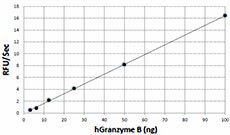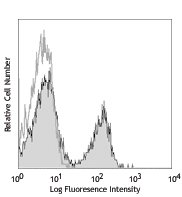- Regulatory Status
- RUO
- Other Names
- Granzyme 2, cytotoxic T-lymphocyte-associated serine esterase 1, GZMB, CCP1, Asp-ase
- Ave. Rating
- Submit a Review
- Product Citations
- publications

-

The activity of recombinant human Granzyme B is determined by its ability to cleave a colorimetric peptide substrate, t-Butyloxycaronyl-Ala-Ala-Asp-ThioBenzyl ester (Boc-AAD-SBzl), in the presence of 5,5'Dithio-bis (2-nitrobenzoic acid) (DTNB), with an activity >1500 pmol/min/µg.
| Cat # | Size | Price | Save |
|---|---|---|---|
| 554902 | 10 µg | ¥44,380 | |
| 554904 | 25 µg | ¥87,560 |
Granzyme B is a serine protease expressed by cytotoxic T cells (CTL) and NK cells. Its main function is to induce cell death to eliminate harmful targets such as allogeneic, virally infected, and tumorous cells. This is evident by the fact that CTLs from mice with inhibited granzyme B production exhibit a profound defect in inducing rapid DNA fragmentation and apoptosis in target cells. Following receptor-mediated conjugate formation between CTL or NK and their target cell, granzyme B enters the target via endocytosis, and subsequently activates multiple protein substrates to induce apoptosis. Most circulating CD56+ CD8- NK cells, and approximately half of circulating CD8+ T cells, coexpress both granzyme A and B. In contrast, few circulating CD4+ T cells express granzymes A or B. Activation of CD8+ and CD4+ T lymphocytes induce substantial expression of granzyme B, but not granzyme A. Besides CTL and NK, evidence has shown that the distribution of human granzyme B has a broader spectrum of cells, including CD34+ hematopoietic progenitor cells, keratinocytes, basophils, mast cells, plasmacytoid dendritic cells, and B cells. Although its role in cytotoxic lymphocyte-mediated apoptosis is well established, granzyme B can also degrade extracellular matrix proteins and alter inflammation if present in the extracellular milieu. These findings suggest that granzyme B can function as an activation molecule with potentially important immunoregulatory functions. In addition, it was shown that expression of granzyme B is elevated in acute coronary syndrome and acute myocardia infarction, indicating that granzyme B could be a factor involved in cardiovascular diseases.
Product DetailsProduct Details
- Source
- Human Granzyme B, amino acids (Gly19-Tyr249) (Accession# NP_004122.2), was expressed with a C-terminal 10 His tag and a linker sequence in 293E cell line.
- Molecular Mass
- This 244 amino acid recombinant protein has a predicted molecular mass of approximately 27.5 kD. The protein migrates at about 37 kD in DTT-reducing conditions and about 37 kD in non-reducing conditions by SDS-PAGE.The predicted N-terminal amino acid is Gly.
- Purity
- >95%, as determined by Coomassie stained SDS-PAGE.
- Formulation
- 0.22 µm filtered protein solution is in 20 mM Tris, 150 mM NaCl, pH 7.5.
- Endotoxin Level
- Less than 1.0 EU per µg of protein as determine by the LAL method.
- Concentration
- 10 - 100 µg sizes are bottled at 200 µg/mL.
- Storage & Handling
- Unopened vial can be stored at -70°C for six months. For maximum results, quick spin vial prior to opening. Avoid repeated freeze/thaw cycles.
- Activity
- Human Granzyme B activated by mouse Cathepsin C is able to cleave the peptide substrate t-Butyloxycaronyl-Ala-Ala-Asp-ThioBenzyl ester (Boc-AAD-SBzl), in the presence of 5,5'Dithio-bis (2-nitrobenzoic acid) (DTNB), with an activity >1500 pmol/min/µg. This recombinant protein is in its inactive form and needs to be activated prior to use in bioassays. Please contact technical support for a detailed activation protocol.
- Application
-
Bioassay
- Application Notes
-
This protein is in the latent form and needs to be activated for bioassay.
BioLegend carrier-free recombinant proteins provided in liquid format are shipped on blue-ice. Our comparison testing data indicates that when handled and stored as recommended, the liquid format has equal or better stability and shelf-life compared to commercially available lyophilized proteins after reconstitution. Our liquid proteins are verified in-house to maintain activity after shipping on blue ice and are backed by our 100% satisfaction guarantee. If you have any concerns, contact us at tech@biolegend.com.
Antigen Details
- Structure
- Monomer
- Distribution
-
Cytotoxic T cells, NK cells, and neutrophils.
- Function
- Granzyme B is able to induce target cell apoptosis by activating caspase independent pathways. Granzyme B is induced in CD8+ T lymphocytes with ConA / IL-2 and CD4+ T lymphocytes with anti CD3/CD28 or CD3/CD46.
- Interaction
- Targets of CTL and NK cells.
- Bioactivity
- Human Granzyme B activated by mouse Cathepsin C is able to cleave the peptide substrate t-Butyloxycaronyl-Ala-Ala-Asp-ThioBenzyl ester (Boc-AAD-SBzl), in the presence of 5,5' Dithio-bis (2-nitrobenzoic acid) (DTNB).
- Biology Area
- Cell Biology, Immunology, Innate Immunity, Neuroscience
- Molecular Family
- Proteases, Enzymes and Regulators
- Antigen References
-
1. Edwards KM, et al. 1999. J. Biol. Chem. 274:30468.
2. Grossman WJ, et al. 2004. Blood. 104:2840.
3. Heusel JW, et al. 1994. Cell. 76:977.
4. Schmid J and Weissman C. 1987. J. Immunol. 139:250.
5. Trapani JA, et al. 1988. Proc. Natl. Acad. Sci. USA 85:6924.
6. Heibert PR, and Granville DJ. 2012. Trends. Mol. Med. 18:732.
7. Saito Y, et al. 2011. J. Cardiol. 57:141. - Gene ID
- 3002 View all products for this Gene ID
- UniProt
- View information about Granzyme B on UniProt.org
Related FAQs
- Why choose BioLegend recombinant proteins?
-
• Each lot of product is quality-tested for bioactivity as indicated on the data sheet.
• Greater than 95% Purity or higher, tested on every lot of product.
• 100% Satisfaction Guarantee for quality performance, stability, and consistency.
• Ready-to-use liquid format saves time and reduces challenges associated with reconstitution.
• Bulk and customization available. Contact us.
• Learn more about our Recombinant Proteins. - How does the activity of your recombinant proteins compare to competitors?
-
We quality control each and every lot of recombinant protein. Not only do we check its bioactivity, but we also compare it against other commercially available recombinant proteins. We make sure each recombinant protein’s activity is at least as good as or better than the competition’s. In order to provide you with the best possible product, we ensure that our testing process is rigorous and thorough. If you’re curious and eager to make the switch to BioLegend recombinants, contact your sales representative today!
- What is the specific activity or ED50 of my recombinant protein?
-
The specific activity range of the protein is indicated on the product datasheets. Because the exact activity values on a per unit basis can largely fluctuate depending on a number of factors, including the nature of the assay, cell density, age of cells/passage number, culture media used, and end user technique, the specific activity is best defined as a range and we guarantee the specific activity of all our lots will be within the range indicated on the datasheet. Please note this only applies to recombinants labeled for use in bioassays. ELISA standard recombinant proteins are not recommended for bioassay usage as they are not tested for these applications.
- Have your recombinants been tested for stability?
-
Our testing shows that the recombinant proteins are able to withstand room temperature for a week without losing activity. In addition the recombinant proteins were also found to withstand four cycles of freeze and thaw without losing activity.
- Does specific activity of a recombinant protein vary between lots?
-
Specific activity will vary for each lot and for the type of experiment that is done to validate it, but all passed lots will have activity within the established ED50 range for the product and we guarantee that our products will have lot-to-lot consistency. Please conduct an experiment-specific validation to find the optimal ED50 for your system.
- How do you convert activity as an ED50 in ng/ml to a specific activity in Units/mg?
-
Use formula Specific activity (Units/mg) = 10^6/ ED50 (ng/mL)














Follow Us